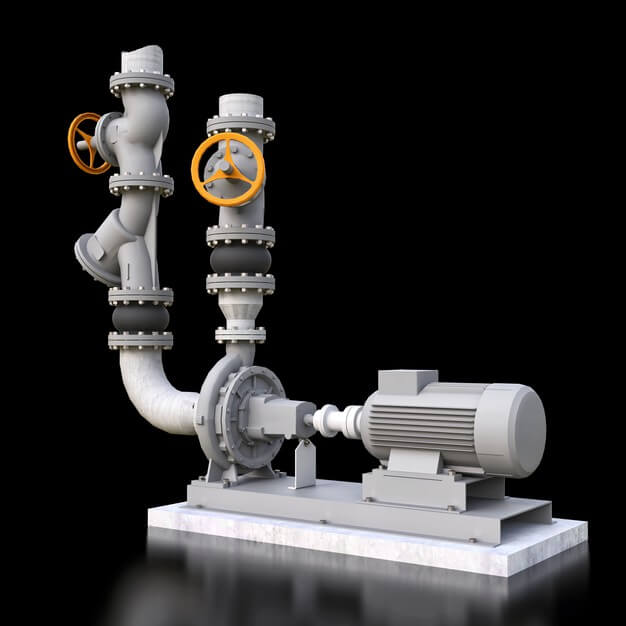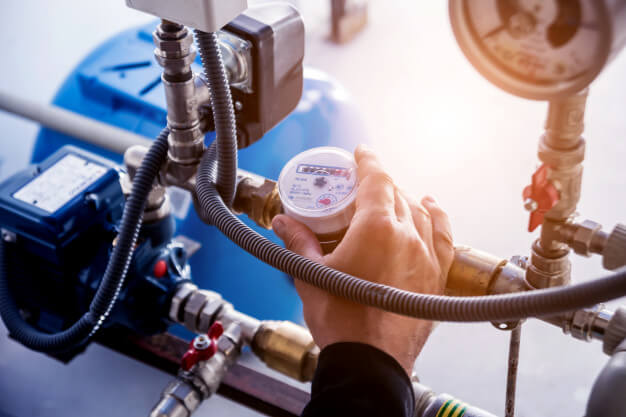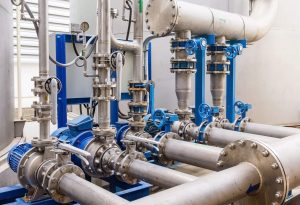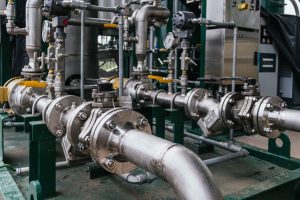A vertical turbine pump is typically classified as a centrifugal or rotodynamic pump. It is a highly versatile tool used in a wide variety of industrial applications. Vertical pumps can be configured to supply both high flow and high-pressure fluid outputs. These are typically multistage devices with multiple impellers embedded in the configuration. While vertical pumps are usually used in underground operations, they have some above-ground applications as well. Here is an overview of the pump, how it works, and the most common applications.
What Is a Vertical Turbine Pump?
A vertical turbine pump is designed to move fluid from an underground reservoir, pit, or well to a spot above ground. Unlike other pumps, these vertical pumps are linked to a surface device through a long shaft device. Pumps are comprised of a head, motor, multiple stages, and columns to contain the shaft. The pump’s engine can be housed on the surface, making device repair more straightforward and convenient.
What Are Common Vertical Pump Applications?
A vertical turbine pump is used in various industrial, construction, and agricultural applications. These pumps are commonly used in applications that require clean water, typically industrial pump services. Turbine pumps transport water from underground wells to residential home faucets, water treatment plants, and sprinkling systems. The water transported generally is too far down to be procured without the assistance of a long shaft.
A distinct advantage of a vertical pump is its adaptability. Vertical pumps are routinely used instead of submersible pumps because they can produce a more robust water flow output. High-pressure versions can produce up to 30,000 gallons of water per minute. Low-pressure adaptations typically generate 100 gallons of fluid per minute. These pumps can be constructed with various stages, producing the pressure needed for an individual application.
Unlike many other types of pumps, the motor can be housed on the surface. Non-electrical motors can be used to produce the pump’s rotational power. Therefore, vertical pumps are a good option for a construction site without ready access to an electrical power source.
Are There Irrigation Applications for Vertical Turbine Pumps?
Irrigation applications for vertical pumps are becoming increasingly common. Many municipalities require groundwater to provide water to local homes, farms, and businesses. Vertical pumps can supply liquid to agricultural fields or homes for watering purposes. One pump is sufficient for numerous acres as it can provide water at an incredibly high volume.
Vertical pumps can also act as a booster for other pumps when outputs need to be increased for a specific project. City water systems may use a turbine pump to supplement the existing water distribution system.
What Are Other Vertical Turbine Pump Applications?
An uncommon but convenient application for a vertical pump is running it in reverse to generate hydraulic power. When used to generate power, the suction housing acts as the pump’s outlet, and the discharge housing serves as the pump’s inlet. While it can be convenient to use a vertical turbine pump to generate power, operators should check with the manufacturer before to ensure there are no safety issues.
What Are the Advantages and Disadvantages?
There are several advantages to using vertical pumps. While some industrial pumps use a large amount of energy, vertical turbine pumps have a small carbon footprint because there are generally no priming issues. The impellers are constantly covered in fluid, providing adequate moisture to the device. Furthermore, these pumps are versatile, easily customizable, and can effectively be used in high and low-flow applications.
Another distinct advantage is that vertical pumps can be housed in tight spaces, making them an ideal device for use in environments with size restrictions. Further, most pump base materials can be upgraded or improved with minimal effort and expense. Pumps can be repaired quickly and inexpensively, maximizing the pump’s life and decreasing the cost your business incurs replacing outdated equipment.
One disadvantage is the fact that these pumps require a lot of headroom for installation and repairs. Additionally, it can be challenging to balance the pump’s hydraulic thrust because of its overhang design. This design feature can be a particular challenge in high-pressure or high-stress industrial applications.
Work With an Expert
Vertical pumps are versatile devices that can be used to pump high volumes of fluid for a wide variety of applications. Zone Industries designs, installs and maintains motors, pumps, and controls. We specialize in industrial pump services and vertical turbine pump repair and installation. Don’t wait any longer to find the ideal pump supplier for your industrial or agricultural needs. Contact us today to find the perfect vertical pump to grow your business.
What Are the Main Uses for a Vertical Turbine Pump? | Zone Industries
There are many advantages to using a submersible vertical turbine pump in manufacturing, construction, and industrial applications. Besides submersible, turbine pumps come in deep well, canned, and wet pit configurations. A vertical pump is highly functional, but they need to be maintained to keep them functioning at an optimal level. Here are a few things to consider when facing repairs and maintenance issues.
Submersible Vertical Turbine Pump Overview
Unlike other models, submersible pumps are designed to work while immersed in water. These pumps are usually positioned underneath the ground to excavate water and bring it to the surface for various uses. Most turbine pumps have a shrouded impeller and receive the water at the device’s center. Diffusion rings direct the discharge along with the series of impellers. The diffusion ring alters the impeller discharge into the pressure head. All of these components work together to process the water and bring it to the surface.
Submersible Vertical Turbine Pump Maintenance
A submersible vertical turbine pump is manufactured to handle a great deal of pressure, but it must be maintained regularly to perform effectively. A proper maintenance inspection should include routine maintenance, routine examinations, three-month inspections, and annual inspections. You can shorten the amount of time between assessments if the pump is not performing optimally, the pump fluid is corrosive, or you are operating in a high-stress environment.
During routine maintenance checks, you should assess the mechanical seal and the packing seal for any tears or imperfections. You should also check the oil in the pump bearings to make sure it is not dried out. There are several tasks you should perform during routine maintenance checks to ensure the device is functioning correctly:
- Assess the oil level through the inspection window on the bearing frame
• Check for unusual sounds
• Check all pump components for leaks
• Examine the vibration
You should perform more extensive maintenance checks every three months. During these checks, examine the pump’s foundation to ensure the hold-down bolts are correctly fitted. Also, check the pump’s casing and packing, particularly if the device has been left idle for a few days. Change the oil filter every three months or more frequently if the device is used daily.
Annual Vertical Turbine Pump Inspections
You need to perform a more extensive inspection of your vertical turbine pump on an annual basis. During these yearly maintenance checks, you need to inspect the pump’s capacity, pressure, and power. You may need to perform these more thorough checks every six months if the device works in conditions that may contaminate any part of the pump.
If you are not satisfied with the pump’s performance during the yearly inspection, you should completely disassemble the device to examine each component’s functionality. You may need to replace damaged parts.
Common Submersible Vertical Turbine Pump Repairs
Several repairs are common for a vertical pump, especially ones that operate in high-stress industries. You will likely need to complete the following maintenance tasks every few years:
- Replace line shaft bearings
• Replace damaged shafting
• Clean submerged components to remove corrosion
• Apply corrosion-resistant coatings to all device surfaces
• Repair damaged impellers
Corrosion is often the primary concern when it comes to vertical turbine pump maintenance. The components submerged in water should be removed as usually as possible to apply a corrosion-resistant coating. If the device is not maintained to prevent corrosion, a total overhaul may be necessary after only a few years. Making frequent repairs can be very expensive, taking money away from your business.
Primary Vertical Pump Repair Concerns
Although a vertical turbine pump performs high-stress tasks, they are not technically sophisticated. Pumps are designed to withstand high-pressure situations, and pump mechanics must be maintained to ensure optimum performance. The primary repair concerns include:
- Dimensional reliability of device components
• Shafting straightness and dependability
• Clearance level for bowl and column bearings
• Impeller balancing
• Corrosion resistance of device coating
To address any of these concerns, most vertical pumps can be disassembled and reassembled relatively easily. It is not necessary to relocate the pump to perform repairs. Because pumps are large and cumbersome, it is best to perform maintenance checks and repairs at the location site.
Work With Zone Industries
If your submersible vertical turbine pump is not performing optimally, you need to get it repaired right away. Business owners that operate in the construction industry understand that work comes to a standstill when tools malfunction. Don’t wait any longer; get your business up and running. Zone Industries has the technical expertise to repair a vertical turbine pump quickly and efficiently. We can repair individual components or complete a total device overhaul. Contact us today to get your pumps functioning at an optimal level.
How Do You Maintain a Submersible Vertical Turbine Pump? | Zone Industries
Water pumps have been around for a long time. H.A Wirtz developed the first one in 1736. A stream wheel powered it to raise water for use at a dye house. Since then, water pumps have continued to evolve and are now incredibly sophisticated pieces of equipment with many applications. Industrial uses are some of the most common for water pumps. For example, industrial pump services are used to remove water at construction sites, displace water after heavy rainfall and irrigate crops. For each situation, there is a type of water pump like a vertical turbine pump that is best suited for the job.
There are two major types of water pumps; centrifugal pumps and positive displacement pumps, each with its subcategories. By understanding the different kinds of water pumps, and when they are used, project managers can make better decisions regarding which one to use.
Centrifugal Pumps

The first major type of pump is a centrifugal pump. According to Intro to Pumps, a centrifugal pump is “a machine that uses rotation to impart velocity to a liquid and then converts that velocity into a flow.” A centrifugal pump is made up of a pump shaft, a sealing mechanism, and other components to help the pump handle operation stress. Centrifugal pumps must remain filled with fluid at all times to function properly.
Inside the pump is also an impeller, which rotates to provide velocity to the liquid being pumped. This impeller spins rapidly, run by a motor, which forces the liquid in a specified direction. Centrifugal pumps come in several different kinds:
Vertical Turbine Pumps
A vertical turbine pump, also known as a vertical pump or lineshaft pump, is a centrifugal pump that transports water from deep underground. A common type of vertical turbine pump is a submersible pump, which is situated entirely underwater. With a submersible pump, the motor is located at the bottom of the system. Submersible vertical turbine pumps are often used when the liquid is far underground, such as in sewage services.
One advantage of using a submersible vertical turbine pump is the noise level. Due to being far below ground and underwater, this type of pump produces much less noise. In addition, submerged pumps do not need to be primed since they are already underwater.
Other vertical turbine pumps have their motors mounted at the top of the system, with impellers connected through a long shaft. In this configuration, the motor remains dry and is easier to maintain. Our blog post on how vertical pumps work provides a more in-depth look at this system.
End-Suction Pumps
One of the more common types of centrifugal pumps is an end-suction pump. This type of pump consists of a single impeller along with a horizontal shaft. These pumps can be altered easily to allow them to pump different types of liquids or solid materials.
Multistage Pumps
The last type of centrifugal pump is called a multistage pump. These pumps have multiple impellers, which provides the pump with additional force. This higher pressure force is required in many instances, such as pipelines.
Positive Displacement Pumps

A positive displacement pump is one where a certain amount of liquid is brought inside the pump’s cavity, and then that same amount is discharged. Depending on the type of pump, this displacement occurs either via a piston, diaphragm, or plunger. To bring the fluid in, a form of suction is used on the inlet side as the cavity expands, then discharged as the cavity decreases. Like centrifugal pumps, there are different types of positive displacement pumps, including:
Rotary Pumps
Rotary pumps run off the rotation of a rotary, which is anything that revolves around a center axis. As the rotary turns, it displaces fluid from the reservoir into the discharging pipe. Two common examples of a rotary pump include a screw pump and a sliding vane.
Reciprocating Pumps
A reciprocating pump uses a piece that moves forward and backward to transfer the fluid from the reservoir. Common examples of a reciprocating part include a plunger or a piston. As the liquid is being brought into the reservoir via suction, inlet valves open up while the outlet valves remain closed. To discharge the fluid, the inlet valves close, and the outlet valves open.
Linear Pumps
Linear pumps get their name from the fact that they operate in a straight line. A classic example of a linear pump is called a chain pump. In a chain pump, circular discs are attached to a long chain. As the chain moves up the tube, the discs carry the trapped water, where it is discharged at the top. Modern linear pumps are more sophisticated but operate on the same basic theory.
Understanding the Many Kinds of Water Pumps
When a fluid pump is required, it’s important to know which kind is best suited for the task. Choosing between a vertical turbine pump or a rotary pump will greatly impact the outcome of the task. Luckily, by working with a trusted provider of industrial pump services, such as Zone Industries, the right type of pump isn’t hard to find.
What Are the Different Types of Water Pumps? | Zone Industries
All commercial facilities need some plumbing, but some industries require a more heavy-duty system. If you have to move water against the natural flow of gravity, you’ll need a pump system. Hydroflo pumps are an excellent option due to their reliability and specific design.
Why does it matter what type of pumping system you have? While basic setups may move cold water, as the temperature rises, so do the complications. Heat, steam, and pressure can all impact a pumping system’s integrity, which is why you must understand how the available pump options work.
What Are Hydroflo Pumps?

Hydroflo Pumps is the name of a pump system manufacturing company and can also refer to its products. The company creates equipment for a variety of industries and purposes:
- Nuclear plant cooling
- Mine dewatering
- Agricultural water supplies
Turbine pumps allow business owners to precisely control the amount of water moved, especially in chemically volatile situations such as nuclear power generation.
Parts from Hydroflo Pumps are designed and manufactured to the highest quality standards no matter which industry they’re bound for. They can be made of lead or stainless steel, depending on business owners’ needs.
What Are the Types of Turbine Pumps?
There are two different types of turbine pumps that can move water from a lower level to a higher ground: vertical and submersible. While both accomplish the same task, they’re structured differently and therefore have different pros and cons.
How do you know which one will work for your situation? To make the best decision, you need to understand how each type functions, so let’s start with an overview of their structures.
Submersible Turbine Pumps
You may have guessed from the name, submersible turbine pumps are installed below the water level. Specifically, the pump and motor are placed close together and completely submerged. Motors can be hydraulic or electric and are hermetically sealed to prevent damage.
In order to move water from a lower elevation to a higher level, submersible turbine pumps rely on energy conversion. Water and other liquids possess kinetic energy as they’re taken into the pump. As they move through the centrifugal pump’s multiple stages, that kinetic energy becomes pressure energy, which can be used to move the liquids against the pull of gravity.
Vertical Turbine Pumps
One thing to remember is that although submersible and vertical turbine pumps have different names, they both move liquids up and therefore contain vertical structures. You may wonder, then, what the main functional difference is between the two. The answer is motor placement.
In a vertical pump, the motor is above ground. It’s connected to the pump via vertical line shafts. Motors are usually electric or diesel and couple with the submersed pump to create pressure via suction.
What Type of Hydroflo Pumps Should You Use?

So why does motor placement matter? When considering submersible vs. vertical, it’s really about convenience vs. efficiency. Which is most important to you will determine the best option.
Advantages of Submersible Turbine Pumps
Submersible turbine pumps don’t require motor protections such as pump houses because they’re already sealed away from harm. Their working principle also allows them to function with fewer pump bowl stages, which means a more compact system. The lack of line shafts means easier installation and a lower initial cost. If you’re seeking for a fast solution that takes up as little space as possible, the submersible pump is for you.
Advantages of Vertical Turbine Pumps
Although more expensive and complicated, vertical turbine pumps have their advantages. For one, they’re less likely to fail, as they’re less susceptible to voltage surges. Additionally, they’re more efficient, as they tend to be more powerful than their submersible counterparts. If you want a pumping system that works hard every day, a vertical turbine pump is the best choice.
Why Choose Hydroflo Pumps?
No matter what type of Hydroflo pumps you choose, you know they’ll get the job done right. That’s why the experts here at Zone Industries offer Hydroflo Pumps products — we only sell products that we would trust in our businesses.
Are you looking for a pump system? You can find a wide variety of top brands on our website. Whether you need to move oil, gas, grease, or old water, we offer a system that’s up to the task.
How Submersible Turbine Hydroflo Pumps Work | Zone Industries
The process of industrial and commercial manufacturing requires the use of several different pumps, including AllFlo pumps. It is challenging to keep track of the various types of pump systems and applications. However, this article aims to identify 15 popular systems and provide a brief overview of each.
1. Centrifugal Pumps
A centrifugal pump has one or more impellers and is useful in many different applications. These pumps have the highest flow rates and can handle clean or dirty liquids. However, these devices will not work well for thicker liquids, like oil.
2. Regenerative Turbine Pumps
While a part of the same classification, regenerative turbine pumps are not considered a proper centrifugal pump. However, these models still use the same kinetic principle, but most are single stage. These devices’ best applications are small commercial boiler systems, like those found in dry cleaners or bakeries.
3. Submersible Pumps
If you require deep water or sewer operations, ask All-Flo Pump distributors about submersible pumps. These tools have an encased and protected motor with a single-stage pump, allowing the entire device to operate while submerged.
4. Vertical Turbine Pumps
A vertical turbine pump is versatile. While the design’s purpose is to operate in a bore-hole well, these sophisticated vertical shaft pumps can also pump from an intake structure, open reservoir, river, or tank. You can also use the pump as a booster pump mounted to the inside of a barrel.
5. Positive Displacement Pumps
While you can search for systems with the right All-Flo pump parts, you might find more luck working with a positive displacement pump. The positive displacement pump doesn’t rely on impellers to propel liquids through the system. Instead, it rotates or uses reciprocating parts to transfer materials.
6. Flexible Impeller Pump
A flexible impeller pump is likely what you need when a positive displacement pump is not enough and requires extra propulsion. The flexible impeller conforms to a displacement pump’s parts, allowing thin liquids’ easy transportation, even those containing some solids.
7. Piston Pumps
Piston pumps use pistons to create high pressure. These pumps provide adequate pressure for wash down services in oil production. Many people are familiar with these systems even if not aware of the name because they are used for pressure washing.
8. Lobe Pumps

When pumping viscous liquids containing soft or fragile liquids, lobe pumps provide the right amount of pressure. These pumps use two shafts to drive the lobes, which mesh but never touch, to pump the liquids gently. The food, beverage, and pharmaceutical industries find these devices most useful.
9. Gear Pumps
Like a lobe pump, a gear pump also uses two meshing gears, but the types are both internal and external. These pumps are not suitable for transporting abrasive liquids or those containing solids. The device is best for clean oils and other high viscosity liquids.
10. Diaphragm Pumps
Like some AllFlo pumps, diaphragm pumps use a reciprocating diaphragm driven by a fluid drive, solenoid, or mechanical drive. These tools also use inlet and outlet check valves. The diaphragm pump is useful in plants because of the varying materials it can handle, from those containing solids to corrosive substances.
11. AODD Pumps
If your pumping operation is not near electricity, then you may need to use air-operated systems instead. An AODD pump runs on air and is useful in construction projects, like concrete pouring.
12. Well Pumps

If you are more interested in rural operations, like irrigation, you may want to invest in a well pump. The well pump is a vertical turbine pump and is used in bore-hole applications.
13. Trash Pumps
A trash pump is a dewatering pump. It can be self-priming or submersible, and the design allows the unit to handle rocks and other solids. These pumps often find use in mining or construction operations.
14. Self-Priming Pumps
Self-priming pumps offer an advantage because they do not need to be submerged. These pumps have motors that rest above the reservoir and do not require external priming or foot valves.
15. Magnetic Drive Pumps
When looking for AllFlo pumps, consider the temperature and sealing issues of the substance. Magnetic drive pumps are sealless, which is advantageous when dealing with non-viscous or heat transfer fluids.
What type of pumping solution do you need? Contact a Zone Industries representative to discuss your business and operations.
Overview of 15 Popular Pumps, Including AllFlo Pumps | Zone Industries



